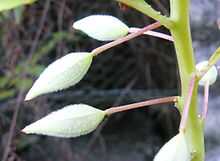Impatiens balsamina
| Impatiens balsamina | |
|---|---|
| | |
| Scientific classification | |
| Kingdom: | Plantae |
| (unranked): | Angiosperms |
| (unranked): | Eudicots |
| (unranked): | Asterids |
| Order: | Ericales |
| Family: | Balsaminaceae |
| Genus: | Impatiens |
| Species: | I. balsamina |
| Binomial name | |
| Impatiens balsamina L. | |
| Wikimedia Commons has media related to Impatiens balsamina. |
| Wikispecies has information related to: Impatiens balsamina |

Impatiens balsamina (garden balsam, garden jewelweed, rose balsam, touch-me-not) is a species of Impatiens native to southern Asia in India and Burma.
It is an annual plant growing to 20–75 cm tall, with a thick, but soft stem. The leaves are spirally-arranged, 2.5–9 cm long and 1–2.5 cm broad, with a deeply toothed margin. The flowers are pink, red, mauve, lilac, or white, and 2.5–5 cm diameter; they are pollinated by bees and other insects, and also by nectar-feeding birds.[1] The ripe seed capsules undergo explosive dehiscence.[2]
Medicinal use
Different parts of the plant are used as traditional remedies for disease and skin afflictions. Juice from the leaves is used to treat warts and snakebite, and the flower is applied to burns.[3] This species has been used as indigenous traditional medicine in Asia for rheumatism, fractures, and other ailments.[4] In Korean folk medicine, this impatiens species is used as a medicine called bongseonhwa dae (봉선화대) for the treatment of constipation and gastritis.[5] Chinese used the plant to treat those bitten by snakes or who ingested poisonous fish.[6] Juice from the stalk, pulverised dried stalks, and pastes from the flowers were also used to treat a variety of ailments.[6] Vietnamese wash their hair with an extract of the plant to stimulate hair growth.[6] One in vitro study found extracts of this impatiens species, especially of the seed pod, to be active against antibiotic-resistant strains of Helicobacter pylori.[4] It is also an inhibitor of 5α-reductases, enzymes that reduce testosterone levels.[7]
Chemistry
The naphthoquinones lawsone, or hennotannic acid, and lawsone methyl ether and methylene-3,3'-bilawsone are some of the active compounds in I. balsamina leaves.[8] It also contains kaempferol and several derivatives.[9] Baccharane glycosides have been found in Chinese herbal remedies made from the seeds.[10]
Ecology
It is widely cultivated as an ornamental plant, and has become naturalised and invasive on several Pacific Ocean islands.[2]
Names and etymology
Common names in other languages include mírame lindo in Spanish, fèngxiānhuā (鳳仙花) in Mandarin Chinese, bóng nước or phượng tiên hoa (鳳仙花) in Vietnamese, bongseonhwa (봉선화; 鳳仙花) in Korean, hōsenka (鳳仙花) in Japanese, elepe in Hawaiian, and kamantigi in Chamorro.[2]
The Okinawan folk song "Tinsagu nu Hana" and the 1956 Korean film Touch-Me-Not (Bongseonhwa in Korean) are both named for the flower.
References
- ↑ Huxley, A., ed. (1992). New RHS Dictionary of Gardening. Macmillan ISBN 0-333-47494-5.
- ↑ 2.0 2.1 2.2 Impatiens balsamina. Pacific Island Ecosystems at Risk (PIER).
- ↑ Plants for a Future: Impatiens balsamina
- ↑ 4.0 4.1 Wang YC, Wu DC, Liao JJ, Wu CH, Li WY, Weng BC (2009). "In vitro activity of Impatiens balsamina L. against multiple antibiotic-resistant Helicobacter pylori". Am. J. Chin. Med. 37 (4): 713–22. doi:10.1142/S0192415X09007181. PMID 19655409.
- ↑ Park JH, Kim JM, Do WI (2003). "Pharmacognostical studies on the folk medicine bong seon wha dae". Korean Journal of Pharmacognosy 34 (3): 193–96.
- ↑ 6.0 6.1 6.2 Christopher Cumo. "Impatiens". Encyclopedia of Cultivated Plants: From Acacia to Zinnia. Christopher Cumo, ed. ABC-CLIO, 2013. p. 523. ISBN 9781598847758
- ↑ Ishiguro K, Oku H, Kato T (February 2000). "Testosterone 5α‐reductase inhibitor bisnaphthoquinone derivative from Impatiens balsamina". Phytother Res 14 (1): 54–6. doi:10.1002/(SICI)1099-1573(200002)14:1<54::AID-PTR540>3.0.CO;2-Q. PMID 10641051.
- ↑ Sakunphueak A, Panichayupakaranant P (2010). "Simultaneous determination of three naphthoquinones in the leaves of Impatiens balsamina L. by reversed‐phase high‐performance liquid chromatography". Phytochem Anal 21 (5): 444–50. doi:10.1002/pca.1216. PMID 20931623.
- ↑ Hua L, Peng Z, Chia LS, Goh NK, Tan SN (February 2001). "Separation of kaempferols in Impatiens balsamina flowers by capillary electrophoresis with electrochemical detection". J Chromatogr A 909 (2): 297–303. doi:10.1016/S0021-9673(00)01102-X. PMID 11269529.
- ↑ Li HJ, Yu JJ, Li P (March 2011). "Simultaneous qualification and quantification of baccharane glycosides in Impatientis Semen by HPLC–ESI-MSD and HPLC–ELSD". J Pharm Biomed Anal 54 (4): 674–80. doi:10.1016/j.jpba.2010.10.014. PMID 21075577.
External links
- Jewelweeds. Drugs.com